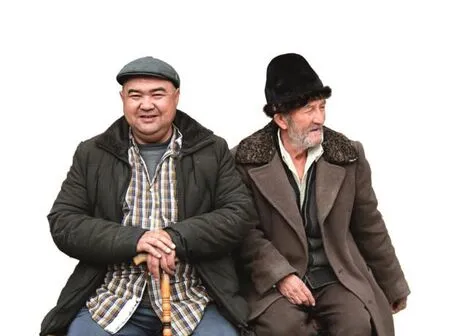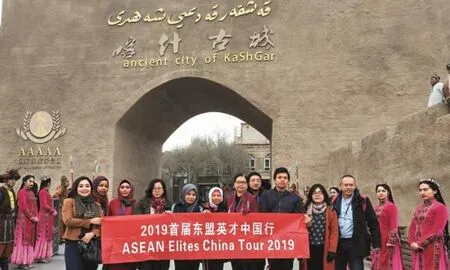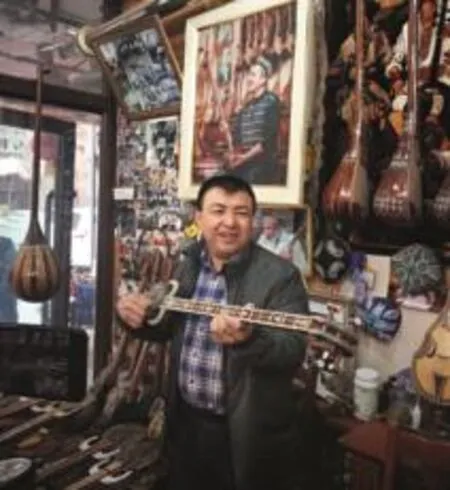NEW LOOK OF KASHGAR OLD CITY
By Wang Fang
Following the delightful beats of Dap (drum)and Rawap (lute), Uygur girls in red dress and boys holding local specialty products danced enthusiastically outside the East Gate of Kashgar Old City. Afanti, a legendary Uygur figure representing justice and wisdom, emerged from the gate with his signature donkey, singing a witty song.
The performance was a reconstruction of the ancient city's welcome ceremony for distinguished guests. The show starts daily at 10 a.m. when the sun begins to shine on the East Gate to welcome guests from all over the world.
Kashgar is the largest city in southern Xinjiang. It is also a famous ancient city of Central Asia. With a history of more than 2,000 years, Kashgar Old City is one of the world's largest existing groups of rammedearth buildings full of tremendous historic value.Here, elements from the Han (206 BC-AD 220) and Tang (618-907) dynasties and the Roman Empire are fused with the modern lifestyles of the Uygur ethnic group. The entire city was designed as a maze with most buildings constructed with mud, wood, bricks and tiles. The area is mainly inhabited by the Uygurs and has emerged as a national tourist attraction.

Local residents enjoy the early morning sunshine.

Indonesian and Malaysian journalists pose at the East Gate of Kashgar Old City.
“After the recent renovation, things have changed a lot. The infrastructure of the Old City has been improved while the historic features have been maintained. We’re continuing our traditional way of life in a modern and safe environment.”
Strolling around the Old City
The local guide revealed that it takes several days to see all the Old City and that you can easily get lost in the maze. It takes time to fully appreciate the city. You can not only enjoy the ancient buildings and local food but also observe local daily life.Traditional handicrafts remain an important industry in the area. You can visit blacksmiths and workshops on both sides of the streets, where iron ware, copper ware, pottery ware, wooden vessels and embroidered caps are hand made.
On Ustangboyi Road, a market street known for traditional handicrafts and folk musical instruments, I was attracted by melodious music from a nearby shop. Mohammad Tursun Ababaikre,the store owner, was playing the Rawap. The shop was about 100 square meters and offered a wide variety of folk musical instruments. On the wall were wall carpets with the theme of Uygur music,pictures of Uygur artists and a big picture of himself,adding to the cultural atmosphere of his store and his performance.

In 2018, the number of tourists visiting Kashgar Old City increased 125 percent year on year.

The 3,290 shops of all kinds in the Old City offer direct employment to more than 9,000 people and indirect employment to more than 50,000 people.
Ababaikre is 50 years old. His father started teaching him the techniques of folk musical instrument making and performance when he was eight years old. “Folk musical instrument making has been our family business for 150 years,”he revealed. “I'm a fifth-generation inheritor.We're now manufacturing more than 70 kinds of instruments for a dozen ethnic groups including the Uygur, Kirgiz, Tajik and Uzbek.”
Ustangboyi Road is next to Aitika'er Mosque in the Old City. Born and raised there, Ababaikre is fully aware of the changes that have taken place around him. “The shanty town with mud houses and dirt roads had a lot of potential safety hazards,” he explained. “After the recent renovation, things have changed a lot. The infrastructure of the Old City has been improved while the historic features have been maintained. We're continuing our traditional way of life in a modern and safe environment.”

Average per capita annual income has increased from 6,000 to 14,000 yuan.
Renovation and Protection
Renovation and protection of the Kashgar Old City has been a major project in recent years. On the first floor of the Kashgar Old City Renovation and Protection Museum, we saw some old pictures and video footage of the Old City 10 years ago.

Folk music instrument store owner Mohammad Tursun Ababaikre plays the Rawap.
The guide informed us that Kashgar Old City covers 4.25 square kilometers and is home to a population of 130,000. The population density is very high, with 30,600 persons per square kilometer. “Before the renovation and protection project, houses were old and run-down and lacked running water and drainage pipes. Sewage was left on the muddy road,” she explained.
On the other side of the East Gate is a relics park of Highland Residential Houses (rammed-earth houses on a tableland), a reminder of the Old City before renovation: More than 600 mud houses line the 400-meter-long tableland. The roads are very narrow, only 1.5 to 6 meters wide. In emergencies such as fire, emergency vehicles cannot reach houses in the area.
The renovation and protection project kicked off in 2009 with an investment of 7 billion yuan(US$1.1 billion). The purpose of the project was to modernize the Old City while maintaining its original design and style. The locals gave input on the design for the renovation of their own properties. The original look of Kashgar Old City was maintained as much as possible.
“I'm quite impressed with this project,”commented Malaysian journalist Fatin Ha fizah Binti Mohd Shahar. “The measures have effectively preserved the history and architectural styles of minority ethnic groups. And after the completion of the project, residents could return to their previous homes. That's marvelous.”
The renovation and protection of Kashgar Old City set a fine example for the renovation and inheritance of cultural heritage. In 2015, Kashgar Old City was designated a national 5A tourist attraction and dubbed the largest natural and anthropological tourist attraction in the country.
So far, Kashgar Old City offers 15 tourist streets and alleys specializing in traditional handicrafts,markets, local food, culture and folk customs.An increasing number of residents are finding employment in the tourism industry. In 2018,the number of tourists visiting Kashgar Old City increased 125 percent year on year.
More and more residents are benefiting from the renovation and protection project. The 3,290 shops of all kinds in the Old City offer direct employment to more than 9,000 people and indirect employment to more than 50,000 people. Average per capita annual income has increased from 6,000 to 14,000 yuan(US$925-2,155).
Guri’s Home
Thanks to the development of tourism in Kashgar Old City, more and more residents have boarded the fast train to prosperity.
Guri's Home, the home and shop of Saramati Guri on Areya Road, is one example. With a skyblue gate, the 300-square-meter courtyard is a typical Uygur courtyard with various Uygur cultural elements. The outer wall of the three-story house is decorated with sophisticated brick carvings. The unique windows are decorated with Uygur Atlas silk. The veranda is fitted with green guardrails.The space under a big tree in the courtyard serves as Guri's sales floor, where she offers wall carpets, jade ware, silk scarves, local specialties and souvenirs.She also offers an area where tourists can sip tea, eat fruit and enjoy snacks. In spring and summer, the tree's shade is particularly pleasant.
Accompanied by folk music, Guri and her younger cousin performed Uygur dances for the guests. She humbly claimed that she was not a professional dancer, but she certainly moved like one as so many Uygurs do. Upon her invitation, some guests joined her in dancing. We had a lot of fun and left the small courtyard with a beautiful memory.
In 2017 when Guri was still a tour guide, she foresaw the bright prospects of tourism in Kashgar Old City. She developed the concept of interactive family tourism. With the support of her family, Guri invested 500,000 yuan (US$76,925) in her Uygur-style family tourism business, which has become one of the most popular sights in the Old City. Tourists have enjoyed interactive tourism because their participation in the activities has enhanced their understanding of the local customs and culture.
“The residents of Kashgar Old City have benefited the most from the renovation and protection project,” said Guri, “Our living conditions improved,and more job opportunities were created. The future is looking bright for us.”

